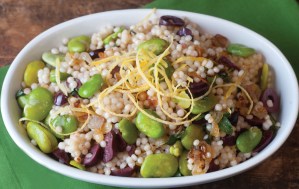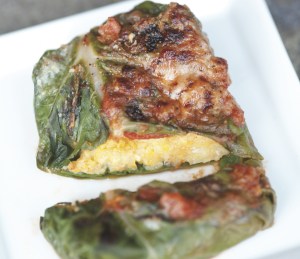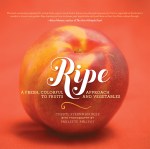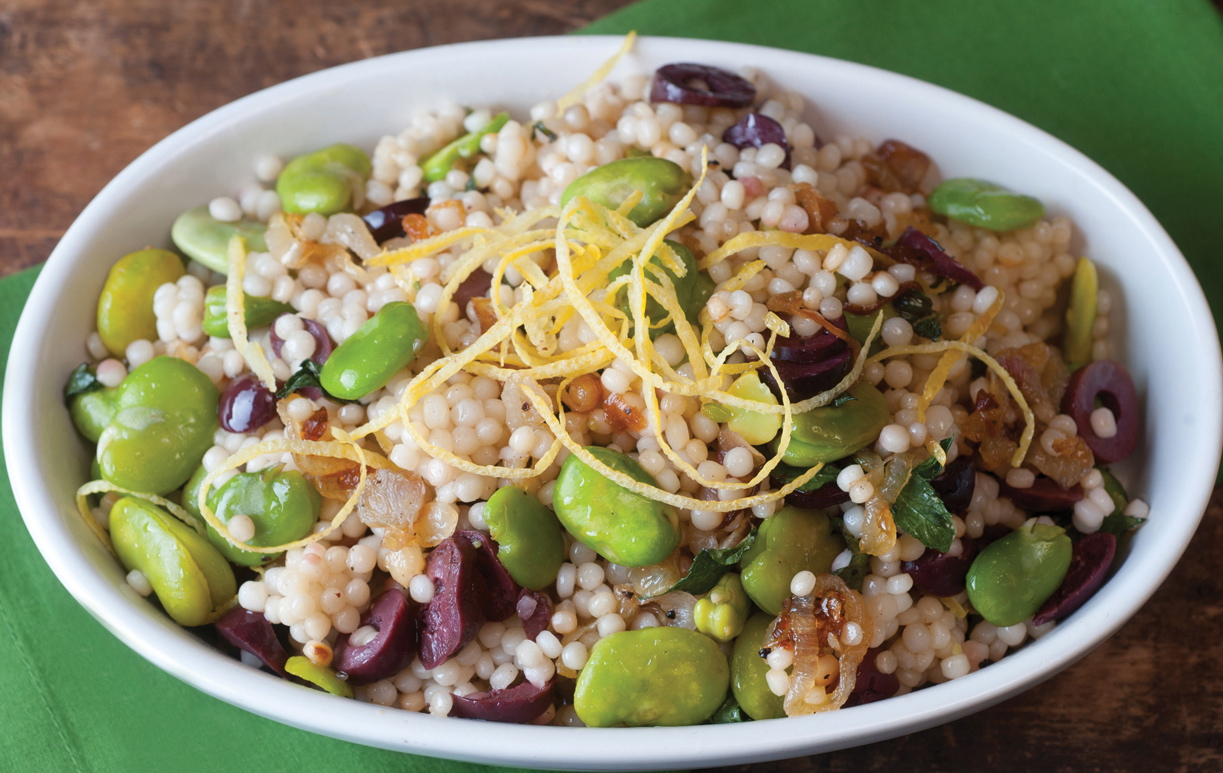Editor’s note: With her new cookbook, Ripe: A Fresh Colorful Approach to Fruits and Vegetables, blogger and author Cheryl Sternman Rule treats produce with “the same sense of naughty decadence usually associated with cupcakes and cocktails.” Here we’ve collected two springy recipes from the green chapter (the book is arranged by color). Enjoy!
Warm fava shallot couscous

With green favas, pearly couscous, and sweet shallots, this warming sauté is both comforting and light. (To make it more entrée-like, toss in some feta and toasted pistachios.) Buy the freshest favas you can find as older beans can be starchy.
1 ½ pounds fresh fava beans (in-pod weight)
1 cup Israeli (sometimes called pearl) couscous
¼ cup extra-virgin olive oil
1 large shallot or 2 medium shallots, thinly sliced (1 ¼ cups)
Kosher salt and freshly ground black pepper
⅓ cup pitted Kalamata olives, sliced
1 lemon, zest removed in long squiggly strips, juice squeezed into a small bowl
2 tablespoons thinly sliced fresh mint leaves
Bring a large pot of water to a boil. Crack the fava pods and squeeze the beans into a bowl. Rinse. Boil the beans for two minutes; then remove with a slotted spoon to a colander and rinse again to cool. Transfer to a small bowl. Add the couscous to the same pot and boil until al dente, about five minutes, skimming any scum that rises to the surface. Drain; rinse briefly to prevent clumping.
While the couscous cooks, use your thumbnail to pierce each fava’s outer shell. Squeeze the dark green inner beans into a bowl; discard the shells.
In a large skillet, warm the olive oil over medium-high heat until almost shimmering. Add the shallots, ¼ teaspoon salt, and a grinding of black pepper. Sauté until the shallots are golden brown and starting to crisp, four to five minutes, stirring frequently to prevent burning. Reduce the heat to very low, add the favas, and stir until warm and glossy, three to five minutes longer. Test one bean; it should be tender.
Add the couscous to the favas along with the olives and some of the lemon juice, to taste; stir until hot. Adjust the salt and pepper. Garnish with the mint and lemon zest.
Tip: Consider preparing this dish with a friend. It’s nice to have company when you shuck the favas, as this can take a bit of time.

Polenta-stuffed chard. Photo by Paulette Phlipot
Polenta-stuffed chard with bubbly parmesan
These gorgeous green parcels, best eaten on a Sunday night in front of a fire, are both dramatic and comforting (think lasagna, but without the pasta, ricotta, or mozzarella). Buy the largest Swiss chard leaves you can find, and keep in mind that the polenta takes an hour to chill.
Kosher salt
3⁄4 cup dry polenta (coarse cornmeal)
1 tablespoon butter
1 cup packed grated Parmesan cheese, divided
Pepper
1 1⁄4 cups your favorite marinara or tomato sauce, divided
8 very large leaves Swiss chard, swished in cool water
Coat a 9 1⁄2-inch square pan with cooking spray and line the bottom with parchment.
In a medium saucepan, bring 3 cups water and 1 teaspoon salt to a boil. Whisk in the polenta and reduce the heat to a gentle gurgle. Cook until thick, 10 to 15 minutes, whisking occasionally. Remove from the heat and stir in the butter, half the cheese, and a generous pinch of black pepper.
Scrape the polenta into the prepared pan and smooth the top. Cool for 15 minutes at room temperature, then refrigerate until cold, at least one hour. (After one hour, cover with plastic wrap.) Unmold and cut into eight 4 x 2-inch rectangles. Wipe the baking pan dry and spread 1⁄2 cup of the marinara along the bottom.
Preheat the oven to 400 degrees and bring a kettle of water to a boil. Have several layers of paper towels on hand.
Make a narrow, upside down V-shaped cut about halfway down each chard leaf to remove the thick central steam. Place the leaves in a large bowl and cover with boiling water. Let soften for six minutes. Remove to the paper towels and pat very dry.
To form the rolls, lay one chard leaf on a cutting board. Lay one polenta rectangle horizontally along the bottom of the leaf and spoon one teaspoon of marinara on top. Roll the leaf upwards, burrito-like, encasing the polenta, and transfer to the baking pan seam side down. Repeat, nestling the rolls next to one other. Spoon the remaining sauce on top and sprinkle with the remaining cheese.
Bake for 10 minutes, then slip under the broiler for one to two minutes to brown the cheese. Serve hot.
 Recipes reprinted with permission from RIPE © 2012 by Cheryl Sternman Rule, Running Press, a member of the Perseus Book Group.
Recipes reprinted with permission from RIPE © 2012 by Cheryl Sternman Rule, Running Press, a member of the Perseus Book Group.




